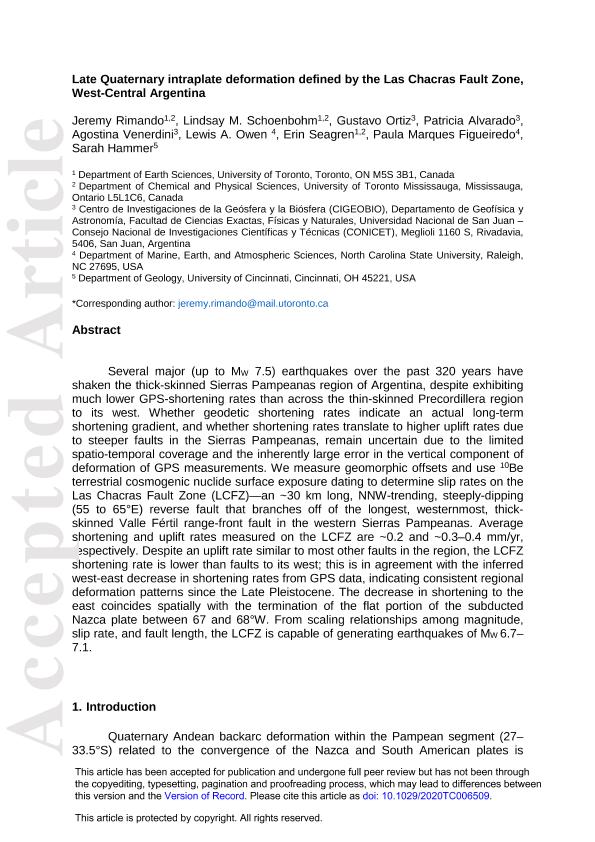Artículo
Late Quaternary intraplate deformation defined by the Las Chacras Fault Zone, West‐Central Argentina
Rimando, Jeremy; Schoenbohm, Lindsay; Ortiz, Gustavo Federico ; Alvarado, Patricia Monica
; Alvarado, Patricia Monica ; Venerdini, Agostina Lia
; Venerdini, Agostina Lia ; Owen, Lewis; Seagren, Erin; Marques Figueiredo, Paula; Hammer, Sarah
; Owen, Lewis; Seagren, Erin; Marques Figueiredo, Paula; Hammer, Sarah
 ; Alvarado, Patricia Monica
; Alvarado, Patricia Monica ; Venerdini, Agostina Lia
; Venerdini, Agostina Lia ; Owen, Lewis; Seagren, Erin; Marques Figueiredo, Paula; Hammer, Sarah
; Owen, Lewis; Seagren, Erin; Marques Figueiredo, Paula; Hammer, Sarah
Fecha de publicación:
04/2021
Editorial:
Wiley Blackwell Publishing, Inc
Revista:
Tectonics
ISSN:
0278-7407
e-ISSN:
1944-9194
Idioma:
Inglés
Tipo de recurso:
Artículo publicado
Clasificación temática:
Resumen
Several major (up to MW 7.5) earthquakes over the past 320 years have shaken the thick-skinned Sierras Pampeanas region of Argentina, despite exhibiting much lower GPS-shortening rates than across the thin-skinned Precordillera region to its west. Whether geodetic shortening rates indicate an actual long-term shortening gradient, and whether shortening rates translate to higher uplift rates due to steeper faults in the Sierras Pampeanas, remain uncertain due to the limited spatio-temporal coverage and the inherently large error in the vertical component of deformation of GPS measurements. We measure geomorphic offsets and use 10Be terrestrial cosmogenic nuclide surface exposure dating to determine slip rates on the Las Chacras Fault Zone (LCFZ)—an ∼30 km long, NNW-trending, steeply dipping (55–65°E) reverse fault that branches off of the longest, westernmost, thick-skinned Valle Fértil range-front fault in the western Sierras Pampeanas. Average shortening and uplift rates measured on the LCFZ are ∼0.2 and ∼0.3–0.4 mm/yr, respectively. Despite an uplift rate similar to most other faults in the region, the LCFZ shortening rate is lower than faults to its west; this is in agreement with the inferred west-east decrease in shortening rates from GPS data, indicating consistent regional deformation patterns since the Late Pleistocene. The decrease in shortening to the east coincides spatially with the termination of the flat portion of the subducted Nazca plate between 67 and 68°W. From scaling relationships among magnitude, slip rate, and fault length, the LCFZ is capable of generating earthquakes of MW 6.7–7.1.
Archivos asociados
Licencia
Identificadores
Colecciones
Articulos(CIGEOBIO)
Articulos de CENTRO DE INVESTIGACIONES DE LA GEOSFERA Y BIOSFERA
Articulos de CENTRO DE INVESTIGACIONES DE LA GEOSFERA Y BIOSFERA
Citación
Rimando, Jeremy; Schoenbohm, Lindsay; Ortiz, Gustavo Federico; Alvarado, Patricia Monica; Venerdini, Agostina Lia; et al.; Late Quaternary intraplate deformation defined by the Las Chacras Fault Zone, West‐Central Argentina; Wiley Blackwell Publishing, Inc; Tectonics; 40; 4; 4-2021; 1-48
Compartir
Altmétricas



